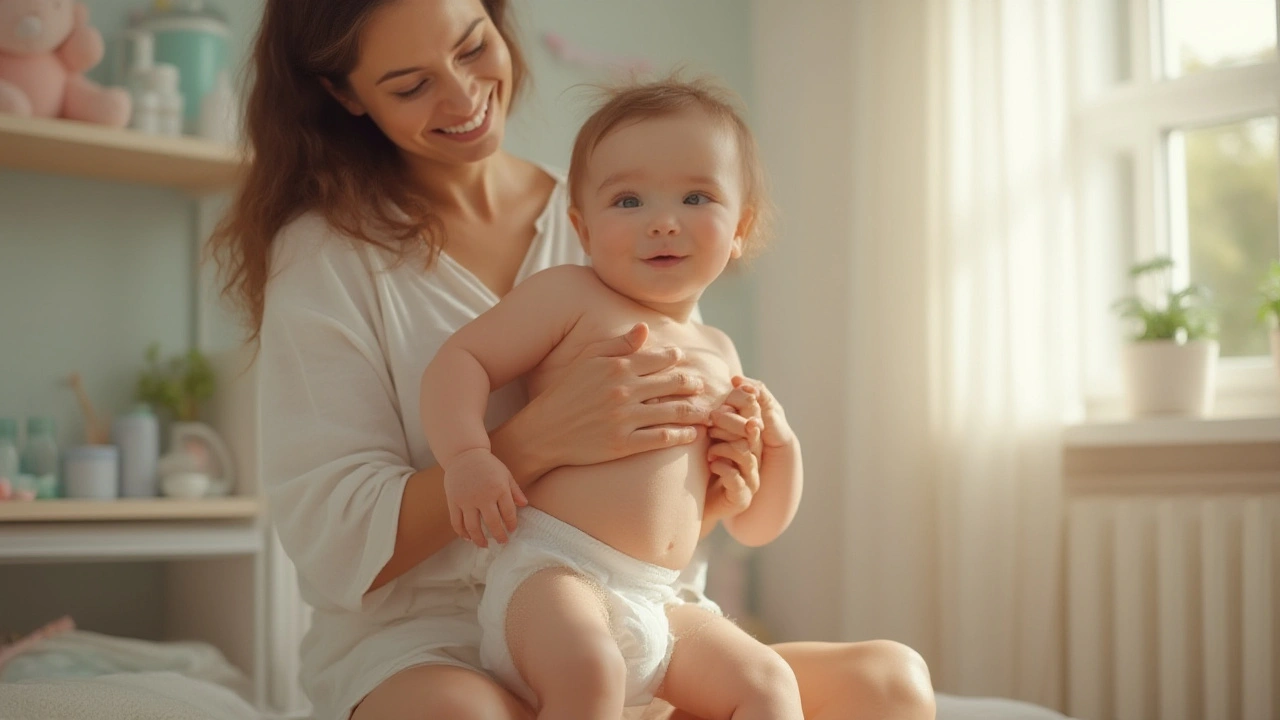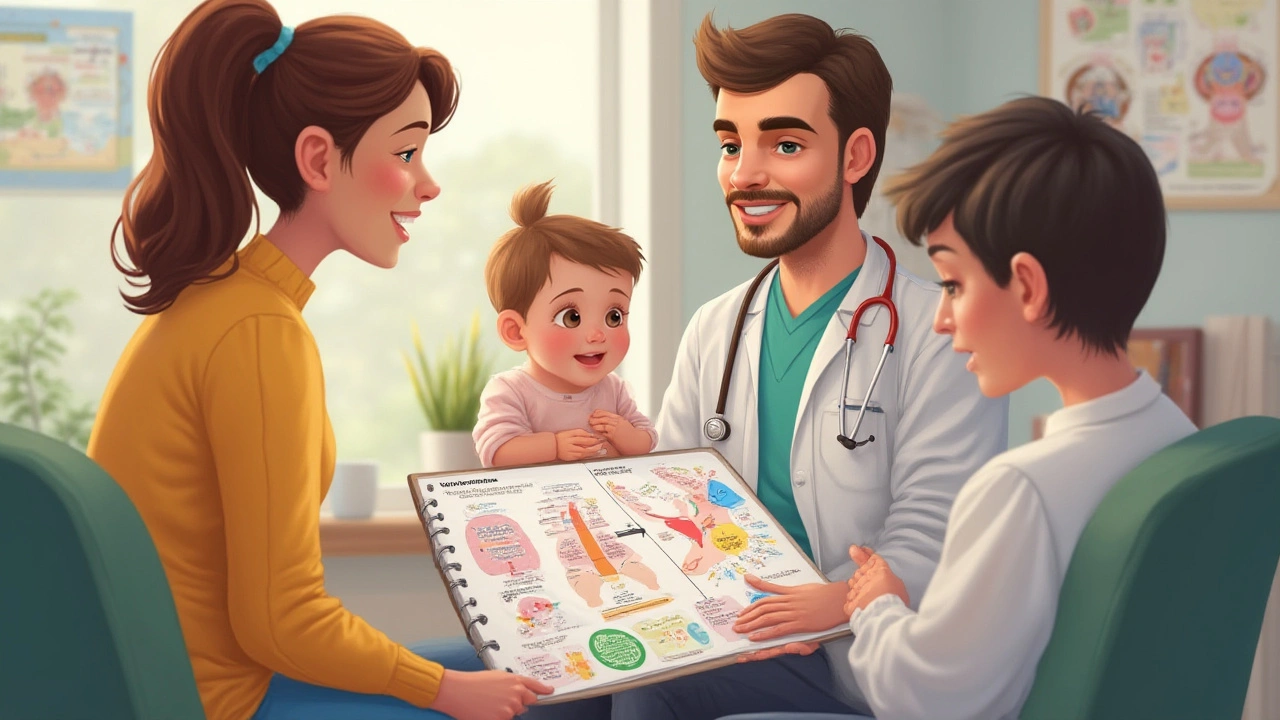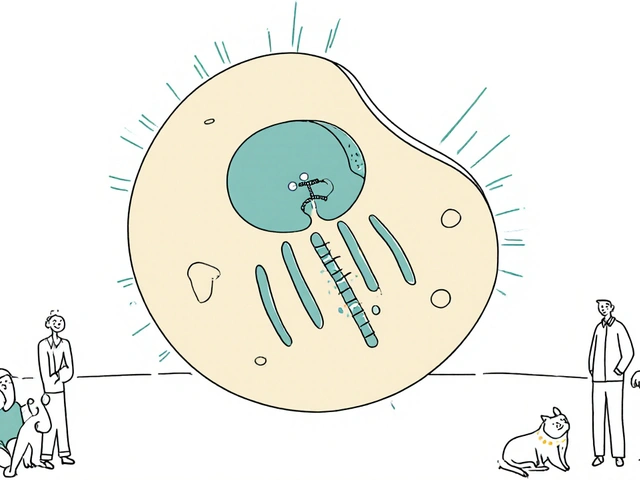
Start thinking about how often a red diaper rash suddenly doesn’t budge, no matter what you try. You layer on zinc, keep things dry, skip the wipes, but it just sits there, sometimes even getting worse. Here’s the plot twist: It might not be a plain old rash. A lot of parents get caught off guard by yeast diaper rash, which behaves in its own stubborn, sneaky way—definitely not your standard case of irritation.
What Exactly is a Yeast Diaper Rash?
Most regular diaper rashes happen because of moisture, friction, and maybe a run-in with poop or pee that lingers a bit too long. But a yeast rash? That’s a whole different story. This villain is usually triggered by Candida, a fungus that loves warm, damp places—so diapers make for a perfect playground. Science backs this up: a 2017 clinical study out of Australia found that up to 35% of diaper rashes checked were actually caused by candida, not your common irritation.
If your baby’s rash doesn’t go away with basic creams, looks fiery red, or develops those crazy satellite spots (tiny red dots just outside the main rash), it’s time to suspect yeast. Sometimes it can develop after antibiotics—those knock out the good bacteria that keep yeast in check. Teething, illness, and even super hot weather can also invite yeast to the party.
Why does this matter? Simple irritation gets better with some air, a barrier cream, or maybe a few extra diaper changes. But yeast thrives in these conditions, taunting you with its persistence. If there’s swelling, shiny red skin, well-defined edges, or a rash that just seems to keep spreading, these are big, flashing warning signs.
How to Spot Early Signs: Don’t Wait Until It Gets Ugly
Truth is, catching yeast diaper rash early takes a bit of detective work. Unlike the classic pink rash, a yeast rash often has sharper borders, may appear in the folds of the thighs or groin, and refuses to improve after a few days of home remedies. There can also be those raised bumps or even tiny pustules (think little pimples) around the edges. If you've ever seen your baby scratching or fussing during diaper changes more than usual, it’s probably not just grumpiness, but real discomfort.
Here’s a simple checklist to help you spot it:
- Red, shiny skin in the diaper area, particularly in creases
- Rash lasts for more than three days without improvement
- Pustules or red satellite bumps outside the main rash
- No improvement with barrier creams like zinc oxide
- Visible discomfort, crying or flinching during changes
One tip: Take a photo early to compare later. It’s amazing how much a rash can change within 24 hours. Oyster pink to beet-red isn’t a good sign. If you see the rash trending this way, you’re probably dealing with yeast. And if it keeps spreading up the belly or down the thighs, or if your little one develops a fever, that’s when you’ll want to talk to your doctor immediately.
Also, don’t ignore skin folds. Unlike run-of-the-mill diaper rash, yeast loves those moist creases. If the inflammation stretches deep into the folds or looks especially raw, this is another nudge to think “yeast.”
When is Clotrimazole the Right Move?
So you’ve ticked a few yeast-raising boxes. Now what? Enter clotrimazole, an antifungal cream that’s the gold standard for taking on candida. This stuff is the go-to for many pediatricians because it works fast at the source, shutting down the fungus so the skin can heal. Don’t get sidetracked by all those fancy over-the-counter diaper rash products—most won’t touch yeast. You need something that targets fungus, not just moisture or irritation.
Clotrimazole is widely recognized and has a long safety record. The texture is light and a little goes a long way. From my own parenting experiences (and too many midnight nappy changes with Kepler keeping me company nearby), you can usually see improvement in about three to five days if you apply faithfully twice per day. Sometimes a second antifungal cream, like nystatin, might be suggested, but clotrimazole is often first in line.
How to apply it? Wash and gently pat the area dry, layer on a thin coat, then let it air out as much as possible before diapering up. You may still want a lighter barrier cream after the antifungal goes on, especially if you have a baby prone to leaks or night wetting.
If you want to dig into more on how to use clotrimazole for yeast diaper rash or find detailed dosing guides, there’s a solid parent-friendly guide on the topic. Use it for all the nitty-gritty details about treating and preventing the dreaded comeback round.
yeast diaper rash usually starts getting better in three days with clotrimazole. If you’re not seeing improvement by day seven, or things get a lot worse fast, set up a check-in with your healthcare provider. Sometimes secondary infection might be brewing (bacteria like to jump in when the skin is open), and you might need a new plan.
"Clotrimazole 1% cream is safe and effective for yeast-related diaper rash in infants when used as directed...parents should seek medical review if there is no improvement after one week." — The Royal Children’s Hospital Melbourne, 2022

Escalation Pathways: Knowing When to Call In the Professionals
Sometimes diaper rash morphs into something angrier or doesn’t budge, no matter what creams you try. That’s when it’s smart to think about getting extra help. If the clotrimazole doesn’t turn things around after a full week, that’s your cue to get a professional opinion. Also, any sign of broken or weeping skin, yellow crust (think: honey-colored), blisters, or fever means it’s way past go-it-alone time.
Pediatricians often see babies with lingering rashes that parents have tried to treat at home for weeks—longer than it should ever drag out. Most clinics will want to know what treatments you’ve tried and for how long, so keep a note (or snaps on your phone) to help them track the rash’s progress. If the yeast rash keeps coming back after each cold or course of antibiotics, it’s worth asking if something else could be going on in your baby’s routine or health.
Sometimes a stubborn rash is actually a sign of a different skin problem, not just yeast. These include eczema, psoriasis, or even an allergy to diapers or wipes (rare, but it happens). In those cases, your doctor might suggest a referral to a skin specialist if basic fixes aren’t doing the trick.
Keep an eye out for other worrying symptoms: persistent rash, swelling, pus, open sores, or a baby who seems really miserable and is off food or drinks. Dehydration and infection are rare but look out for fewer wet nappies, sunken fontanelles (soft spots), or listlessness. These all mean it’s time for a check-up without delay.
Smart Steps for Prevention and Recovery
Good news—avoiding yeast diaper rash is possible once you know the warning signs and how fast it can sneak up. Regular changing, quick cleaning (gentle wipes, tap water, or a soft wet washcloth—whatever is least irritating), and plenty of air time are the basics. Try going diaper-free at home for half an hour here and there. It feels risky, but it works wonders for clearing up mild irritation and keeping yeast in check.
Switch up diaper brands if you’re having repeat problems—sometimes a new material or even the way a diaper fits can trigger underlying sweats or tears that let yeast move in. If antibiotics are needed for another reason, double down on your prevention game, knowing that the risk rises afterward.
Some parents swear by applying a thin antifungal cream after any course of antibiotics, even preventively, but check with your doctor before starting a new routine. Scented products, wipes full of alcohol, and powders can dry and irritate skin or make things worse for a rash-prone baby. Keep it simple, clean, and as dry as possible.
I talked to a pediatric nurse here in Auckland, and she says, “Most yeast diaper rashes clear up quickly with clotrimazole, but regular nappy changes and a watchful eye are still the best prevention.” Pretty hard to mess that up, really.
FAQ: Common Questions Answered
How fast does clotrimazole work?
If you’ve caught the yeast rash early and apply the cream right, improvement usually shows within three days. If there’s no visible change after seven, it’s time for a check-up.
Is clotrimazole safe for babies?
Used as directed (thin layer, twice a day), the 1% cream is safe—even for newborns—unless your child has a known allergy to the medication.
Can I use other creams with clotrimazole?
You can, but layer the antifungal first, let it soak in, then add a barrier cream if extra protection is needed. Skip harsh ointments or anything with fragrances.
Are cloth or disposable diapers better?
Both have pros and cons. The key is frequent changing and keeping skin clean and dry. Cloth might let you spot rashes sooner since you see the skin more often.
When should I worry?
If baby has a fever, blisters, trouble feeding, or the rash spreads rapidly beyond the diaper area—get medical help. Trust your gut.
Seeing your little one fuss and squirm because of a red, angry rash is seriously stressful, but knowing what to watch for and how to handle yeast gives you a real shot at fixing it fast. You’ve got this—and just like those midnight cries, this, too, will pass (hopefully quicker with the right cream).




6 Comments
This rash had me crying at 3am while trying to wipe my kid with a wet washcloth like some kind of saint. Clotrimazole? Saved my sanity. No more guessing. Just slap it on, breathe, and wait. It works. Period.
My baby stopped screaming during changes. That’s all I needed to know.
Let’s be real - you’re all just reacting to marketing. Clotrimazole is a generic antifungal. It’s not magic. Candida is a commensal organism that becomes pathogenic under immunosuppressive conditions - which in infants is often iatrogenic from antibiotic disruption of gut microbiota. The real issue? Overdiagnosis. Most ‘yeast rashes’ are just irritant dermatitis exacerbated by occlusion. You’re treating symptoms, not root causes. Also - why are we using topical azoles on neonates without fungal culture confirmation? This is clinical laziness dressed up as parenting wisdom.
Bro… I tried everything. Zinc paste? Nope. Air time? Meh. Then I used clotrimazole… and BAM 😮💨 Like magic. My son’s rash looked like a sunset before, now it’s just… gone. 🙏
Also - stop using wipes. Just water and cotton. Life changed.
PS: I used the 1% cream. Not the 2%. Don’t be like me and overdo it. 😅
While the practical guidance provided is generally sound, I must respectfully emphasize the importance of differential diagnosis in pediatric dermatology. The presence of satellite lesions is indeed a hallmark of candidal infection; however, psoriasiform diaper dermatitis, seborrheic dermatitis, and contact allergic reactions may present with overlapping clinical features. A definitive diagnosis requires clinical correlation and, when indicated, potassium hydroxide (KOH) preparation or fungal culture. The empirical use of clotrimazole, while often effective, should not preclude professional evaluation in refractory or recurrent cases. Furthermore, the long-term safety profile of repeated topical antifungal use in infants remains incompletely characterized in the literature. A multidisciplinary approach involving pediatricians and dermatologists is advisable for persistent presentations.
You got this. Seriously. I was terrified the first time my kid got this rash. Thought I was doing everything wrong. Then I found clotrimazole. Three days later - calm baby. Happy mom. Just keep it clean, keep it dry, and don’t panic. It’s not your fault. It’s just biology. You’re doing better than you think.
And yeah - skip the wipes. Water and a soft cloth. Game changer.
Clotrimazole 1% cream is indicated for cutaneous candidiasis in infants when clinical signs are consistent with fungal etiology. The recommended dosage is a thin film applied bid to the affected area after thorough cleansing and drying. Clinical improvement typically manifests within 72 hours. If no resolution is observed by day seven, alternative etiologies including bacterial superinfection, atopic dermatitis, or allergic contact dermatitis must be excluded. Concurrent use of barrier agents such as zinc oxide is acceptable provided the antifungal is applied first and allowed to absorb. Parental documentation of rash progression via photographic records enhances diagnostic accuracy and facilitates clinical decision-making. Adherence to dosing protocols minimizes risk of resistance and ensures optimal therapeutic outcomes.